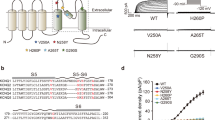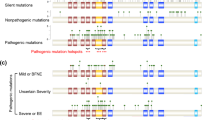Abstract
KCNQ potassium channels are activated by changes in transmembrane voltage and play an important role in controlling electrical excitability. Human mutations of KCNQ2 and KCNQ3 potassium channel genes result in reduction or loss of channel activity and cause benign familial neonatal convulsions (BFNCs). Thus, small molecules capable of augmenting KCNQ currents are essential both for understanding the mechanism of channel activity and for developing therapeutics. We performed a high-throughput screen in search for agonistic compounds potentiating KCNQ potassium channels. Here we report identification of a new opener, zinc pyrithione (1), which activates both recombinant and native KCNQ M currents. Interactions with the channel protein cause an increase of single-channel open probability that could fully account for the overall conductance increase. Separate point mutations have been identified that either shift the concentration dependence or affect potentiation efficacy, thereby providing evidence for residues influencing ligand binding and downstream events. Furthermore, zinc pyrithione is capable of rescuing the mutant channels causal to BFNCs.
This is a preview of subscription content, access via your institution
Access options
Subscribe to this journal
Receive 12 print issues and online access
$259.00 per year
only $21.58 per issue
Buy this article
- Purchase on Springer Link
- Instant access to full article PDF
Prices may be subject to local taxes which are calculated during checkout







Similar content being viewed by others
Accession codes
References
Ashcroft, F.M. From molecule to malady. Nature 440, 440–447 (2006).
Jan, L.Y. & Jan, Y.N. Cloned potassium channels from eukaryotes and prokaryotes. Annu. Rev. Neurosci. 20, 91–123 (1997).
Tombola, F., Pathak, M.M. & Isacoff, E.Y. How far will you go to sense voltage? Neuron 48, 719–725 (2005).
Brown, D.A. & Adams, P.R. Muscarinic suppression of a novel voltage-sensitive K+ current in a vertebrate neurone. Nature 283, 673–676 (1980).
Marrion, N.V. Control of M-current. Annu. Rev. Physiol. 59, 483–504 (1997).
Cooper, E.C., Harrington, E., Jan, Y.N. & Jan, L.Y. M channel KCNQ2 subunits are localized to key sites for control of neuronal network oscillations and synchronization in mouse brain. J. Neurosci. 21, 9529–9540 (2001).
Schroeder, B.C., Kubisch, C., Stein, V. & Jentsch, T.J. Moderate loss of function of cyclic-AMP-modulated KCNQ2/KCNQ3 K+ channels causes epilepsy. Nature 396, 687–690 (1998).
Hille, B. Ion Channels of Excitable Membranes 220–238 (Sinauer, Sunderland, Massachusetts, USA, 2001).
Jentsch, T.J. Neuronal KCNQ potassium channels: physiology and role in disease. Nat. Rev. Neurosci. 1, 21–30 (2000).
Rogawski, M.A. KCNQ2/KCNQ3 K+ channels and the molecular pathogenesis of epilepsy: implications for therapy. Trends Neurosci. 23, 393–398 (2000).
Charlier, C. et al. A pore mutation in a novel KQT-like potassium channel gene in an idiopathic epilepsy family. Nat. Genet. 18, 53–55 (1998).
Gutman, G.A. et al. International Union of Pharmacology. XLI. Compendium of voltage-gated ion channels: potassium channels. Pharmacol. Rev. 55, 583–586 (2003).
Kubisch, C. et al. KCNQ4, a novel potassium channel expressed in sensory outer hair cells, is mutated in dominant deafness. Cell 96, 437–446 (1999).
Schroeder, B.C., Hechenberger, M., Weinreich, F., Kubisch, C. & Jentsch, T.J. KCNQ5, a novel potassium channel broadly expressed in brain, mediates M-type currents. J. Biol. Chem. 275, 24089–24095 (2000).
Singh, N.A. et al. A novel potassium channel gene, KCNQ2, is mutated in an inherited epilepsy of newborns. Nat. Genet. 18, 25–29 (1998).
Wang, Q. et al. Positional cloning of a novel potassium channel gene: KVLQT1 mutations cause cardiac arrhythmias. Nat. Genet. 12, 17–23 (1996).
Shapiro, M.S. et al. Reconstitution of muscarinic modulation of the KCNQ2/KCNQ3 K(+) channels that underlie the neuronal M current. J. Neurosci. 20, 1710–1721 (2000).
Wang, H.S. et al. KCNQ2 and KCNQ3 potassium channel subunits: molecular correlates of the M-channel. Science 282, 1890–1893 (1998).
Cooper, E.C. & Jan, L.Y. Ion channel genes and human neurological disease: recent progress, prospects, and challenges. Proc. Natl. Acad. Sci. USA 96, 4759–4766 (1999).
Armstrong, C.M. Time course of TEA(+)-induced anomalous rectification in squid giant axons. J. Gen. Physiol. 50, 491–503 (1966).
Armstrong, C.M. Inactivation of the potassium conductance and related phenomena caused by quaternary ammonium ion injection in squid axons. J. Gen. Physiol. 54, 553–575 (1969).
Armstrong, C.M. Interaction of tetraethylammonium ion derivatives with the potassium channels of giant axons. J. Gen. Physiol. 58, 413–437 (1971).
Holmgren, M., Smith, P.L. & Yellen, G. Trapping of organic blockers by closing of voltage-dependent K+ channels: evidence for a trap door mechanism of activation gating. J. Gen. Physiol. 109, 527–535 (1997).
Xu, J., Chen, Y. & Li, M. High-throughput technologies for studying potassium channels - progresses and challenges. Targets 3, 32–38 (2004).
Sanguinetti, M.C. & Tristani-Firouzi, M. hERG potassium channels and cardiac arrhythmia. Nature 440, 463–469 (2006).
Rostock, A. et al. D-23129: a new anticonvulsant with a broad spectrum activity in animal models of epileptic seizures. Epilepsy Res. 23, 211–223 (1996).
Tober, C., Rostock, A., Rundfeldt, C. & Bartsch, R. D-23129: a potent anticonvulsant in the amygdala kindling model of complex partial seizures. Eur. J. Pharmacol. 303, 163–169 (1996).
Rundfeldt, C. The new anticonvulsant retigabine (D-23129) acts as an opener of K+ channels in neuronal cells. Eur. J. Pharmacol. 336, 243–249 (1997).
Tatulian, L., Delmas, P., Abogadie, F.C. & Brown, D.A. Activation of expressed KCNQ potassium currents and native neuronal M-type potassium currents by the anti-convulsant drug retigabine. J. Neurosci. 21, 5535–5545 (2001).
Ramu, Y., Xu, Y. & Lu, Z. Enzymatic activation of voltage-gated potassium channels. Nature 442, 696–699 (2006).
Sun, H., Shikano, S., Xiong, Q. & Li, M. Function recovery after chemobleaching (FRAC): evidence for activity silent membrane receptors on cell surface. Proc. Natl. Acad. Sci. USA 101, 16964–16969 (2004).
Sun, H., Liu, X., Xiong, Q., Shikano, S. & Li, M. Chronic inhibition of cardiac kir2.1 and HERG potassium channels by celastrol with dual effects on both ion conductivity and protein trafficking. J. Biol. Chem. 281, 5877–5884 (2006).
Terstappen, G.C. Functional analysis of native and recombinant ion channels using a high-capacity nonradioactive rubidium efflux assay. Anal. Biochem. 272, 149–155 (1999).
Wickenden, A.D., Yu, W., Zou, A., Jegla, T. & Wagoner, P.K. Retigabine, a novel anti-convulsant, enhances activation of KCNQ2/Q3 potassium channels. Mol. Pharmacol. 58, 591–600 (2000).
Bond, A.D.J. Synthesis and characterization of a novel zinc pyrithione hydrate. Mol. Cryst. Liq. Cryst. Sci. Technol. 356, 305–313 (2001).
Wang, D.W. Synthesis of N-oxide-2-mercaptopyridine zinc salt. Riyong Huaxue Gongye 33, 340–342 (2003).
Kimura, E., Takasawa, R., Tanuma, S. & Aoki, S. Monitoring apoptosis with fluorescent Zn2+-indicators. Sci. STKE 2004, PL7 (2004).
Barnett, B.L., Kretschmar, H.C. & Hartman, F.A. Structural characterization of bis(N-oxopyridine-2-thionato)zinc (II). Inorg. Chem. 16, 1834–1838 (1977).
Main, M.J. et al. Modulation of KCNQ2/3 potassium channels by the novel anticonvulsant retigabine. Mol. Pharmacol. 58, 253–262 (2000).
Schenzer, A. et al. Molecular determinants of KCNQ (Kv7) K+ channel sensitivity to the anticonvulsant retigabine. J. Neurosci. 25, 5051–5060 (2005).
Wuttke, T.V., Seebohm, G., Bail, S., Maljevic, S. & Lerche, H. The new anticonvulsant retigabine favors voltage-dependent opening of the Kv7.2 (KCNQ2) channel by binding to its activation gate. Mol. Pharmacol. 67, 1009–1017 (2005).
Long, S.B., Campbell, E.B. & Mackinnon, R. Voltage sensor of Kv1.2: structural basis of electromechanical coupling. Science 309, 903–908 (2005).
Seebohm, G. et al. Differential roles of S6 domain hinges in the gating of KCNQ potassium channels. Biophys. J. 90, 2235–2244 (2006).
Biervert, C. et al. A potassium channel mutation in neonatal human epilepsy. Science 279, 403–406 (1998).
Dedek, K. et al. Myokymia and neonatal epilepsy caused by a mutation in the voltage sensor of the KCNQ2 K+ channel. Proc. Natl. Acad. Sci. USA 98, 12272–12277 (2001).
Horrigan, F.T. & Aldrich, R.W. Coupling between voltage sensor activation, Ca2+ binding and channel opening in large conductance (BK) potassium channels. J. Gen. Physiol. 120, 267–305 (2002).
Bandell, M. et al. High-throughput random mutagenesis screen reveals TRPM8 residues specifically required for activation by menthol. Nat. Neurosci. 9, 493–500 (2006).
Li, Y., Gamper, N. & Shapiro, M.S. Single-channel analysis of KCNQ K+ channels reveals the mechanism of augmentation by a cysteine-modifying reagent. J. Neurosci. 24, 5079–5090 (2004).
Huang, C.C., Lesburg, C.A., Kiefer, L.L., Fierke, C.A. & Christianson, D.W. Reversal of the hydrogen bond to zinc ligand histidine-119 dramatically diminishes catalysis and enhances metal equilibration kinetics in carbonic anhydrase II. Biochemistry 35, 3439–3446 (1996).
Laine, M. et al. Atomic proximity between S4 segment and pore domain in Shaker potassium channels. Neuron 39, 467–481 (2003).
Shealy, R.T., Murphy, A.D., Ramarathnam, R., Jakobsson, E. & Subramaniam, S. Sequence-function analysis of the K+-selective family of ion channels using a comprehensive alignment and the KcsA channel structure. Biophys. J. 84, 2929–2942 (2003).
Marks, R., Pearse, A.D. & Walker, A.P. The effects of a shampoo containing zinc pyrithione on the control of dandruff. Br. J. Dermatol. 112, 415–422 (1985).
Fliss, H. Zinc ionophores as therapeutic agents. US patent 6,495,538 (2002).
Mathie, A., Sutton, G.L., Clarke, C.E. & Veale, E.L. Zinc and copper: pharmacological probes and endogenous modulators of neuronal excitability. Pharmacol. Ther. 111, 567–583 (2006).
Guex, N. & Peitsch, M.C. SWISS-MODEL and the Swiss-PdbViewer: an environment for comparative protein modeling. Electrophoresis 18, 2714–2723 (1997).
Acknowledgements
We thank T. Jentsch (Zentrum für Molekulare Neurobiologie, Hamburg), D. Makinnon (State University of New York, Stony Brook), M. Sanguinetti (University of Utah), M. Shapiro (University of Texas Health Science Center, San Antonio) and V. Vardanyan (Universität Hamburg) for gifts of cDNAs. We thank M. Fratine, A. Ince, S. Long, M. Spieker and K. Xie for technical assistance. We also thank B. Coblitz for help with structural modeling and our colleagues and members of the Li laboratory for valuable discussions and comments on the manuscript. The N-type calcium channel stable line was a kind gift from D. Lipscombe and D. Yue. This work is supported by a grant from the US National Institutes of Health to M.L. (GM70959).
Author information
Authors and Affiliations
Contributions
Q.X. performed all electrophysiological recordings and analyses. H.S. performed high-throughput compound screens and constructed site-directed mutants. Q.X. and H.S. constructed vectors and established cell lines expressing KCNQ channels. M.L. helped conceive experiments.
Note: Supplementary information and chemical compound information is available on the Nature Chemical Biology website.
Corresponding author
Ethics declarations
Competing interests
The authors declare no competing financial interests.
Supplementary information
Supplementary Fig. 1
Zinc pyrithione effects on other potassium channels and N-type calcium channel. (PDF 15 kb)
Supplementary Fig. 2
Complexed form of ZnPy is required for potentiation. (PDF 30 kb)
Supplementary Fig. 3
Other divalent ion effects on KCNQ2 current. (PDF 26 kb)
Supplementary Fig. 4
Synthesis of zinc pyrithione and sodium pyrithione. (PDF 15 kb)
Supplementary Fig. 5
Stoichiometric preference of Zn ion and pyrithione. (PDF 17 kb)
Supplementary Fig. 6
ZnPy effects on KCNQ2 and KCNQ2/3 deactivation. (PDF 102 kb)
Supplementary Fig. 7
Differential modulatory sites on KCNQ channel and retigabine. (PDF 31 kb)
Rights and permissions
About this article
Cite this article
Xiong, Q., Sun, H. & Li, M. Zinc pyrithione-mediated activation of voltage-gated KCNQ potassium channels rescues epileptogenic mutants. Nat Chem Biol 3, 287–296 (2007). https://doi.org/10.1038/nchembio874
Received:
Accepted:
Published:
Issue Date:
DOI: https://doi.org/10.1038/nchembio874
This article is cited by
-
A small-molecule activation mechanism that directly opens the KCNQ2 channel
Nature Chemical Biology (2024)
-
Functional characterization and in vitro pharmacological rescue of KCNQ2 pore mutations associated with epileptic encephalopathy
Acta Pharmacologica Sinica (2023)
-
Zinc drives vasorelaxation by acting in sensory nerves, endothelium and smooth muscle
Nature Communications (2021)
-
Rare KCNQ4 variants found in public databases underlie impaired channel activity that may contribute to hearing impairment
Experimental & Molecular Medicine (2019)
-
Whole-exome sequencing identifies two novel mutations in KCNQ4 in individuals with nonsyndromic hearing loss
Scientific Reports (2018)



